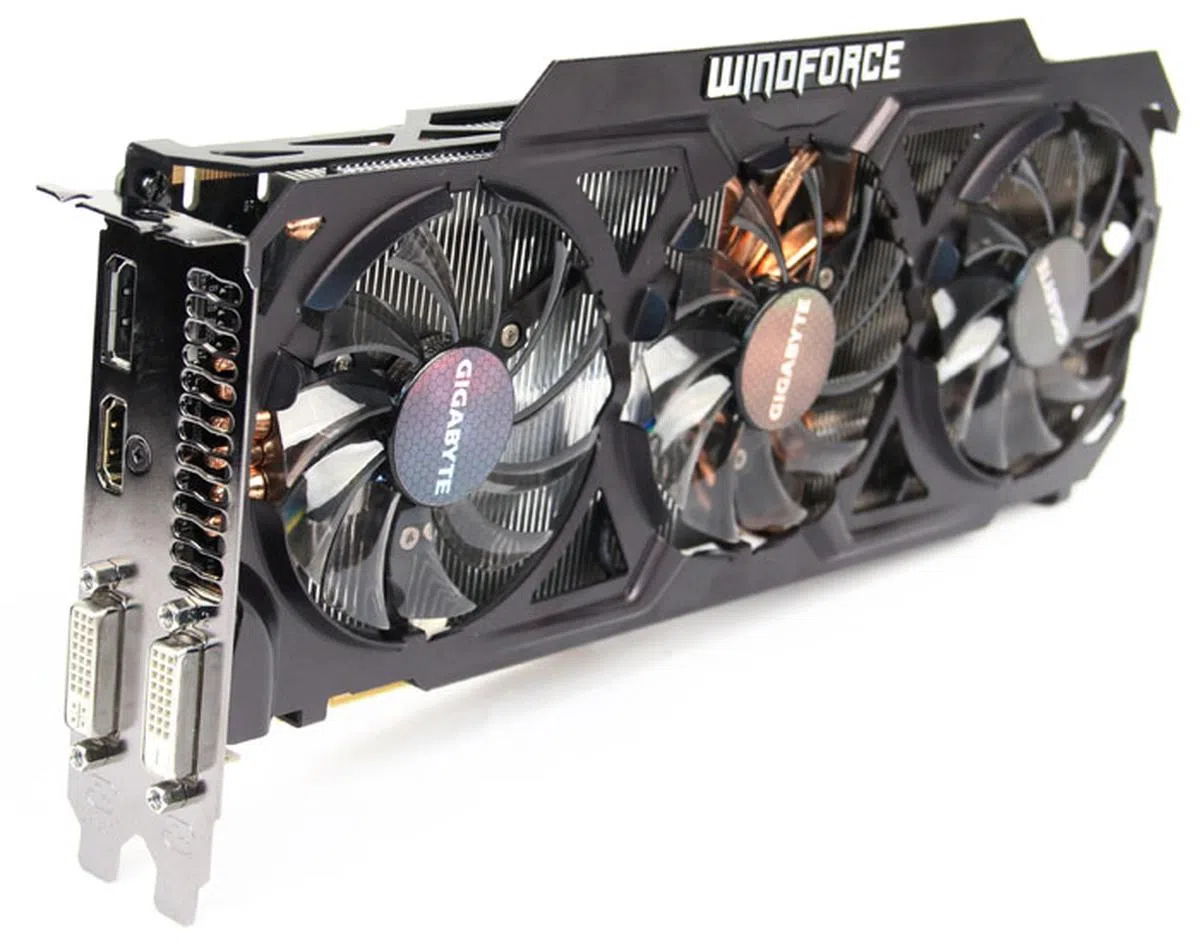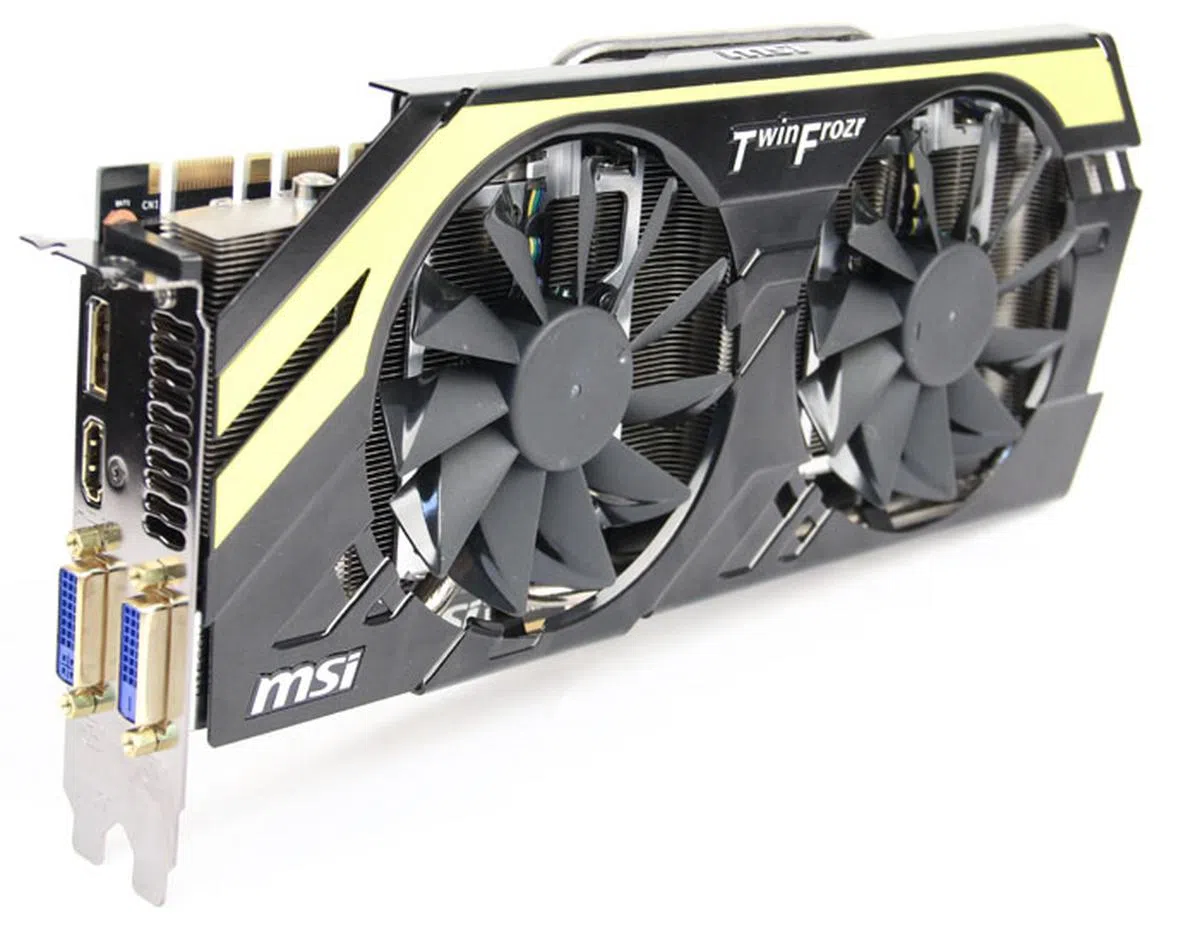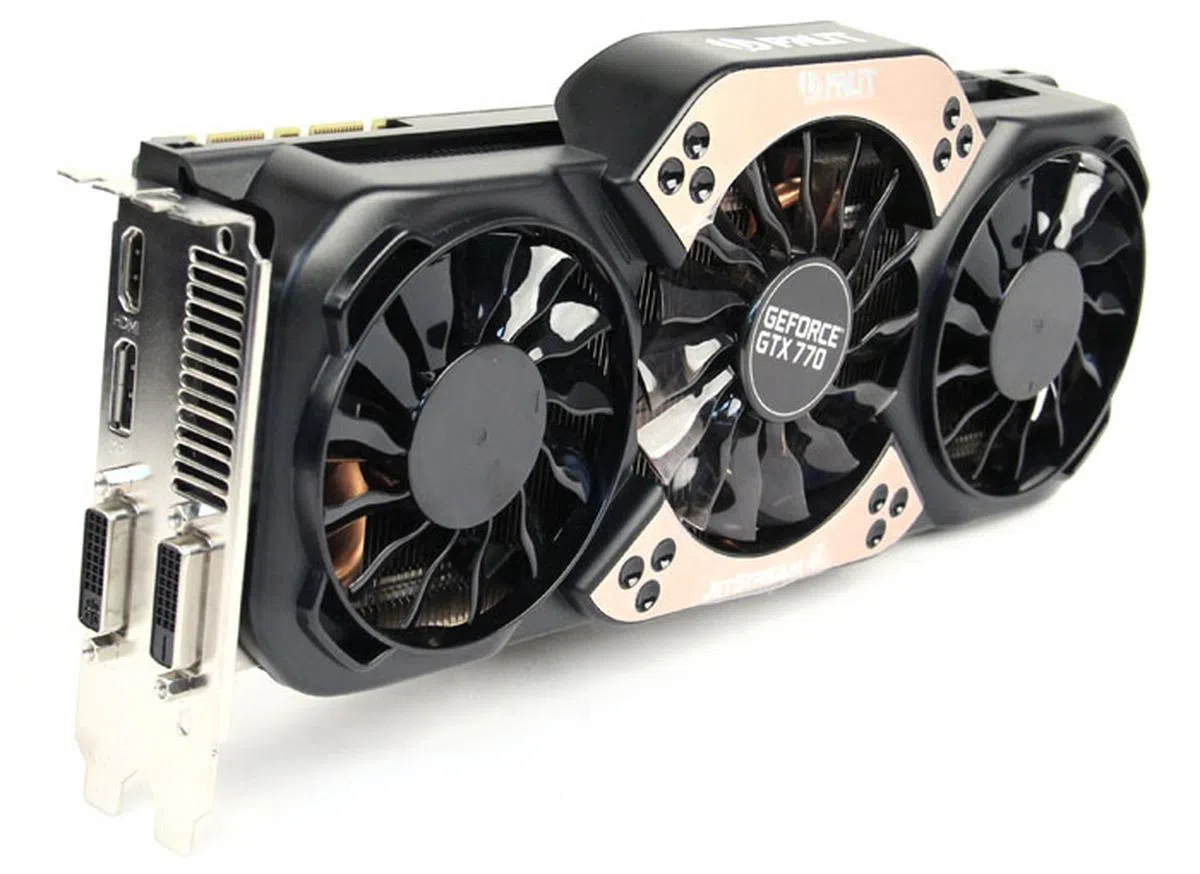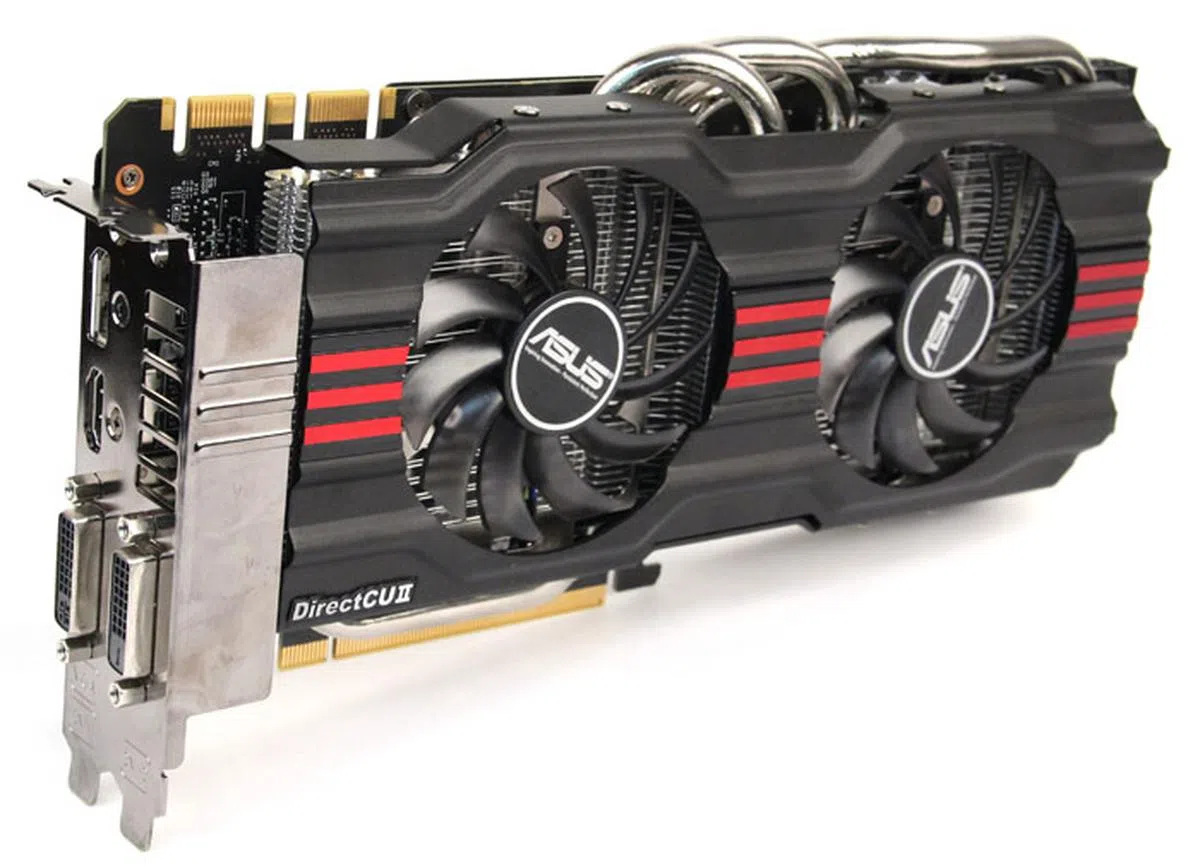NVIDIA GeForce GTX 770 Custom Card Shootout
NVIDIA's GeForce GTX 770 reference card impressed us with performance surpassing NVIDIA's previous generation flagship GeForce GTX 680 card. Now it's time to see what NVIDIA's add-in partners can do as we round up cards from ASUS, Gigabyte, MSI and Palit.
Meet the GeForce GTX 770 Custom Cards
NVIDIA's GeForce GTX 770 reference card impressed us with performance rivaling and even surpassing NVIDIA's previous generation flagship GTX 680 card. Now that Computex 2013 and the PC Show 2013 are behind us, it's time to see what NVIDIA's add-in partners can do.

We gathered four custom designed cards from ASUS, Gigabyte, MSI and Palit for your consideration.
ASUS GeForce GTX 770 DirectCU II OC
ASUS' GeForce GTX 770 has a barely worth mentioning factory overclock of 1059MHz on the core (just 13MHz, or about 1%, above the reference 1046MHz) with memory remaining at the default 7012MHz DDR. The card retails in Singapore for S$709 and comes with a three-year warranty.


Like most of ASUS' custom cards, this card uses ASUS' dual-fan DirectCU II cooler, comprising of five copper heatpipes in direct contact with the GPU, cooled by two 80mm fans.

The card measures 271 x 132 x 40.5mm and requires one six-pin and one eight-pin Molex power connector.

The custom PCB is protected by a backplate.

Ports are the same as reference: one DVI-D port, one DVI-I port, one HDMI port and one DisplayPort port.
Gigabyte GeForce GTX 770 Windforce 3X OC
Gigabyte's GeForce GTX 770 Windforce 3X OC boasts a more impressive factory overclock of 1137MHz (91MHz over reference), with memory remaining at the default 7012MHz DDR. Coincidentally, Gigabyte's very impressive GeForce GTX 780 Windforce 3X OC also boasts a 91MHz overclock and uses the same Windforce 3X cooler, so we're excited to see how this card performs. This card retails for S$669 in Singapore and comes with a 3-year warranty.


The card sports a custom triple fan cooler comprising of three 80mm fans mounted onto a skeletonized fanshroud, and a full aluminum fin-stack that covers the voltage regulator and memory area, all connected to two 8mm and four 6mm thick heat pipes.

The card measures 292 x 129 x 43mm and requires one six-pin and one eight-pin Molex power connector.

Gigabyte is using the reference PCB on this model.

Ports-wise, the Gigabyte GTX 770 is also the same as the reference card, sporting one DVI-D port, one DVI-I port, one HDMI port and one DisplayPort port.
MSI GeForce GTX 770 Lightning OC
MSI's GeForce GTX 770 Lightning OC boasts an impressive factory overclock of 1150MHz (104MHz over the reference design) with memory also remaining at the default 7012MHz DDR. The card is one of the more interesting looking cards in our shootout, with a striking yellow and black design, topped off with gold-plated port connectors. Locally, the card retails for S$699 and comes with a three-year warranty.


MSI's Twin Frozr IV cooler is quite similar to ASUS' with four copper heatpipes in direct contact with the GPU. It sports much larger fans however, measuring a massive 100mm in diameter.

The card is quite large, measuring 294 x 132 x 36mm. It requires two 8-pin Molex power connectors.

The custom PCB is protected by a backplate. The card is also equipped with MSI's GPU Reactor, an add-on PCB that holds a battery of tantalum capacitors, which further conditions power for the GPU. On the downside, the GPU reactor sticks out quite a lot, which could cause issues with SLI spacing.

Like the other cards in our shootout, ports are the same as the reference card, sporting one DVI-D port, one DVI-I port, one HDMI port and one DisplayPort port.
Palit GeForce GTX 770 Jetstream OC
Palit's GeForce GTX 770 Jetstream OC also boasts a factory overclock of 1150MHz (104MHz over reference) with memory remaining at the default 7012MHz DDR. The card retails in Singapore for S$669 and comes with a two-year warranty.


Palit's Jetstream cooler features a triple fan cooling system with two 80mm fans around a single 92mm fan in the middle. Underneath, five nickel-plated heatpipes draw heat away from the GPU. Unfortunately, the entirely plastic construction of the cooler makes it look cheap.

The card measures 294 x 132 x 49 mm, making it slightly thicker than most 2-slot cards. It requires one six-pin and one eight-pin Molex power connector.

Palit is using a custom PCB without a protective backplate.

And once again, ports are the same as the reference design, with one DVI-D port, one DVI-I port, one HDMI port and one DisplayPort port.
[hwzcompare]
[products=398124,398128,398130,398132,394806]
[width=175]
[caption=Custom GeForce GTX 770 Cards Compared]
[showprices=0]
[/hwzcompare]
Test Setup
Here are the hardware specifications of our recently updated graphics card test rig:
- Intel Core i7-3960X (3.3GHz)
- ASUS P9X79 Pro (Intel X79 chipset) Motherboard
- 4 x 2GB DDR3-1600 G.Skill Ripjaws Memory
- Seagate 7200.10 200GB SATA hard drive (OS)
- Western Digital Caviar Black 7200 RPM 1TB SATA hard drive (Benchmarks + Games)
- Windows 7 Ultimate 64-bit
Here's the list of cards we'll be testing and the drivers used. As we've already established that the GeForce GTX 770 is marginally better than last year's GeForce GTX 680, we've enlisted the GeForce GTX 670 in this comparison for a more price competitive comparison to see how much more horsepower the newcomer can muster:-
- ASUS GeForce GTX 770 DirectCU II OC 2GB GDDR5 2GB GDDR5 (NVIDIA ForceWare 320.18)
- Gigabyte GeForce GTX 770 Windforce 3X OC 2GB GDDR5 (NVIDIA ForceWare 320.18)
- MSI GTX 770 Lightning OC 2GB GDDR5 (NVIDIA ForceWare 320.18)
- Palit GeForce GTX 770 Jetstream OC 2GB GDDR5 (NVIDIA ForceWare 320.18)
- NVIDIA GeForce GTX 770 2GB GDDR5 (NVIDIA ForceWare 320.18)
- NVIDIA GeForce GTX 670 2GB GDDR5 (NVIDIA ForceWare 320.18)
Benchmarks
For this shootout, we'll be focusing on the overclocking potential, temperature performance, and power consumption of our custom cards (although we'll also have a brief look at out of the box performance). As such, we've streamlined our benchmarks to highlight these features. For a full set of benchmark results for the GTX 770, please refer to our earlier review of the reference NVIDIA GeForce GTX 770.
- Futuremark 3DMark 11
- Crysis 3
- Overclocking (Futuremark 3DMark 11)
- Temperature
- Power Consumption
3DMark 11 Results
3DMark 11 is a synthetic benchmark designed to test a GPU's performance at various aspects of DirectX 11 such as tessellation and DirectCompute. At both presets, ASUS's GTX 770 was only slightly higher than the reference card, due to its underwhelming overclock.
Our other three custom cards performed much better, each outscoring the reference card by about 6 - 6.5% at both presets. Palit was able to pull slightly ahead at both presets, but the difference was less than 1%.

Crysis 3 Results
For an idea of in-game performance, we chose Crysis 3, the toughest game in our benchmark set due to its extreme amounts of tessellation, per-pixel per-object motion blur, Bokeh Depth of Field, displacement mapping, particle and volumetric lighting and fog shadows.
As expected, ASUS was only slightly better than the reference card, while our remaining three custom cards fared much better, gaining as much as 11% over the reference card at 1920 x 1200 with 8xAA. Overall Palit maintained a slight edge in three out of four settings, but once again, the difference between all three was less than 1%.

Overclocking Results
For our overclocking efforts, in terms of pure clock speeds, we had the most success with MSI, which we were able to push to 1240MHz on the core. Despite this, we saw a bigger performance increase from Gigabyte, which we raised to 1237MHz, which gave it a slight 1% performance lead over its competition. Overall, all of our cards performed quite well here, gaining about 5 - 6% in performance, with ASUS performing slightly better, gaining about 9% in performance (due to its lower starting point), but it was still trailing in absolute results.
As an interesting side note, it seems that 7412MHz DDR is the sweet spot for memory clocks with the GTX 770 as all of our cards (including the reference card) performed best at this setting. Your own endeavors might vary.


Temperature Results
The custom coolers on all of our cards proved very effective, with temperatures ranging between 18 and 23 degrees cooler than the reference design cooler! An amazing 40% drop in temperature! Surprisingly, despite having the lowest base core clock speed, ASUS' cooler ran the hottest, hitting a 'high' of 53 degrees Celesius. While this figure is still very good compared to the reference card, it was five degrees warmer than Palit's Jetstream cooler. Has the time come for ASUS to retire its aging DirectCU II design?
Palit's triple fan Jetstream design proved to be the most effective, reaching just a 'frosty' 48 degrees Celsius, despite its plastic build and the highest core clock out of the box.

Power Consumption Results
Our custom card coolers weren't just effective, they were also highly efficient, with ASUS actually drawing less power than the reference design and our other three cards just 3% over.
At idle state, the Gigabyte GeForce GTX 770 drew the least power, while, under load, ASUS naturally had the lowest power consumption due to its low overclock. There wasn't much separating our other three custom cards, with MSI drawing slightly more power than Palit and Gigabyte. Oddly, the ASUS card had the highest idle power draw of the group despite its low core clock.

Conclusion
The NVIDIA GeForce GTX 770 proved itself a capable card with plenty of overclocking potential and for the most part, NVIDIA's add-in partners have done an excellent job utilizing that potential. Gigabyte, MSI and Palit all showed excellent gains over the reference card straight out of the box, with scores on average 6-10% higher. ASUS seems to be playing it safe with its DirectCU II OC model, but perhaps this points towards the upcoming release of a TOP model with higher base overclocks?

A very competitive shootout, but there can be only one winner!
Despite the wide variety of different cooler designs, it was interesting to see that all of our cards were able to drop the reference card temperature by about 20 degrees Celsius - a decrease of about 40%! Palit's triple fan Jetstream model was the most effective, but MSI and Gigabyte were very close behind.
Power consumption results for all cards were excellent, with Gigabyte, MSI and Palit drawing just 3% more than the reference card at load testing. ASUS on the other hand had the highest idle power consumption, but the lowest power draw draw during load testing.
Overall, it was very difficult to pick a winner for this shootout as Gigabyte, Palit and MSI are all excellent choices. ASUS was also a decent choice, but unfortunately, it didn't really stand out in this comparison.
The ASUS GeForce GTX 770 DirectCU II OC graphics card was hardly overclocked out of the box and it wasn't one of the better overclockers either, so its "OC" moniker didn't really live up to expectations. Its temperature performance was a world better than the reference card, but the competition managed even better cooling performance. In terms of power consumption, its slightly higher idle power draw was unexpected and, while its load testing power draw was among the lowest, this can be attributed to its underwhelming clock speed. It's also very expensive at S$709.
Palit boasted the overall highest scores (if only marginally) out of the box, but we didn't like the plastic, cheap-looking cooler and the extra-thick 2.5 slot design, which could cause issues for SLI spacing and for smaller cases. While it's quite affordable at S$669, its two-year warranty (all of the other cards come with three-year warranties) is also a minor drawback.
MSI (along with Palit) had the highest core overclock out of the box, at 1150MHz, but its scores were actually slightly behind Palit in our benchmark tests. It was also able to achieve the highest overclock speed, but again, was not able to produce the highest score. While we liked the design of its cooler, it drew the highest power at load, and its GPU Reactor may also cause issues for SLI spacing. Priced at S$699, it's decent value for what it can do.
Gigabyte is our overall winner in this shootout due to its excellent overall performance without any glaring drawbacks. It was also the winner in our overclocking benchmark and provides excellent value at just $669, with a three-year warranty.
Our articles may contain affiliate links. If you buy through these links, we may earn a small commission.






